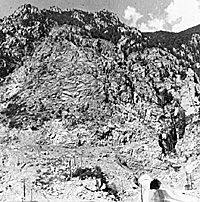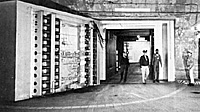NORAD is one of our most controversial games. Some of the suggestions and comments we have received at our offices follow: (Each suggestion published in Conflict earns $5 for its author.)
Gentlemen:
A few comments on issue #4, and particularly on the SAF/NORAD article. A game based on a nuclear/total war between the USSR and the USA would have been much better situated in a 1970's time period than in 1962. The problem is the "strategy" of "city-busting;" the main objective of NORAD game and the only truly practical mode of attack in the early '60s. City destruction is the most unlikely and certainly the most unrewarding form of nuclear attack. A more plausable form of attack by the Soviets would be one aimed at our strategic military forces with only limited collateral damage to urban centers; just enough to give us a taste of Armageddon. The large Soviet missiles such as the SS-9 would be used for this mission out-fitted with MRVs. Smaller ICBMs and SLBMs would be held in reserve. The effect would be to disarm SAC in a first strike and hold our cities as hostages against retaliation by any systems still operative. Meanwhile Soviet conventional forces would roll into Western Europe or whatever other area had triggered the war.
Since the U.S. is committed to never firing first in a nuclear show-down, and since expenditures for military reorganization on any level are not available for political reasons, we are forced to follow a defensive strategy of dispersal and static defense. However, future "what-ifs" could greatly enhance the U.S. position.
A game set in the near-future, such as 1978, could have provided each side with a wide variety of possible attack modes and objectives, of considerable more political sense than civilian extermination. The complete lack of sense of a nuclear war with the weapons available in the 1960s may have been the main reason no such war took place.
Claims haue been made that one side has no chance in NORAD. Just which side (the U.S. or Russian) is never supposed to win depends on who you talk to. The Michigan Organized Wargamer's (MOW) Mich Con II held last July sponsored a NORAD tournament won by Dennis de Boll. He accumulated 155 points as the Russian player in one of the games he played, which is a record. On the other hand, in Albion, a British board-wargamer's newsletter published by Don Turnbull, an extensive analysis of NORAD concludes that the game is "pro-American" with the Russian player having only a slight chance for victory.
 NORAD's eleven-building defense complex lies inside Cheyenne Mountain near Colorado Springs. Colorado.
NORAD's eleven-building defense complex lies inside Cheyenne Mountain near Colorado Springs. Colorado.
Dear Sirs:
I have just received my sample issue of Conflict (No. 4 with the NORAD game). The magazine itself I have little quarrel with, the articles were uniformly well written, informative and entertaining.
NORAD, however, does not rate similar praise. As an abstraction it is passable, but representing it as a simulation really misses the mark. I will mention just two major points on which NORAD no more represents an actual nuclear exchange than a square dance. First off, in a typical game the Russian bombers will roam around the North Americancontinent, attempting to avoid the NORAD jets and at the same time find an unprotected American city to blast. If an actual attack had been launched, each bomber wing would have been assigned a particular target and would have sought to destroy it regardless of the obstacles placed in its way. Secondly, the Russian player is aware of the locations of the American fighter wings, but is uncertain of the placement of anti-aircraft missile bases. In an actual exchange of course, just the opposite would be true. Fighter wings can be constantly shuffled and relocated with some hope of confusing enemy intelligence. Missile bases, however, take months to plan and more months, if not years, to build. Fortunately, these two glaring errors can be easily corrected without sacrificing the great god Playability to the demon Complexity.
 A pair of 25-ton blast doors protects thc entrance to North American Air Defense Command's underground Combat Operations Center. These doors and the granite mountain act as a shield against nuclear attack.
A pair of 25-ton blast doors protects thc entrance to North American Air Defense Command's underground Combat Operations Center. These doors and the granite mountain act as a shield against nuclear attack.
1. The Russian player will number all his nondummy bomber units from 1 to 23 on their bottom side. Prior to the beginning of each of his turns he will assign each bomber to be entered in that tum to a particular American target. The bomber unit may attack that target and that alone. The American player may demand to see that bomber's assignment after the attack has taken place, although he may not see the assignments of other bombers that have not made their attacks yet.
2. The American player deploys all his missle units in cities face up. He deploys all fighter units in cities face down. Those pieces originally designated as dummy (or decoy) missile units are now used as dummy fighter units. Dummy fighter units may not move.
3. The Russian player may win by destroying 75 points of American cities, not 100.
4. All other rules remam as originally written.
An alternative to the bookkeeping rule (#1) is to permit the Russian bomber units only one 90 degree turn (or two 45 degree, etc.) per game. Also, for clarification, an American missile unit can destroy a Russian SLBM missile unit in the same way it eliminates a Russian bomber unit.
Back to Conflict Number 6 Table of Contents
Back to Conflict List of Issues
Back to MagWeb Master Magazine List
© Copyright 1973 by Dana Lombardy
This article appears in MagWeb (Magazine Web) on the Internet World Wide Web.
Other military history articles and gaming articles are available at http://www.magweb.com